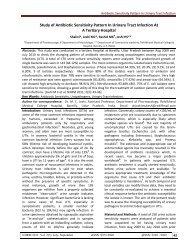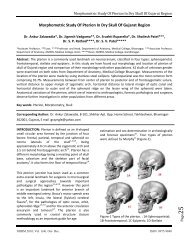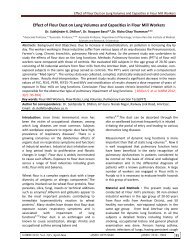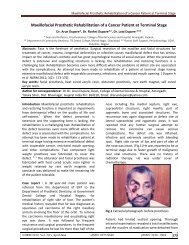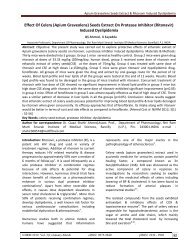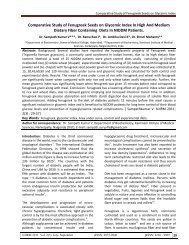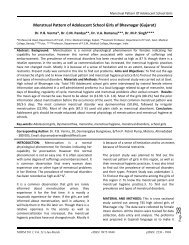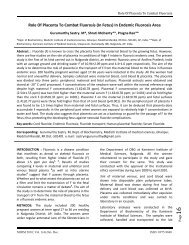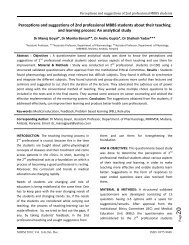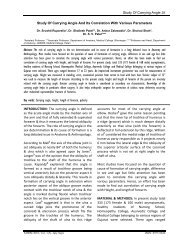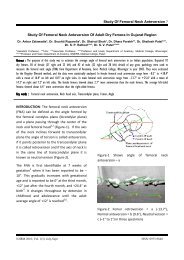The Effect of Mindfulness Meditation on HPA-Axis - National Journal ...
The Effect of Mindfulness Meditation on HPA-Axis - National Journal ...
The Effect of Mindfulness Meditation on HPA-Axis - National Journal ...
You also want an ePaper? Increase the reach of your titles
YUMPU automatically turns print PDFs into web optimized ePapers that Google loves.
<str<strong>on</strong>g>Mindfulness</str<strong>on</strong>g> <str<strong>on</strong>g>Meditati<strong>on</strong></str<strong>on</strong>g> <strong>on</strong> <strong>HPA</strong>-<strong>Axis</strong><br />
<str<strong>on</strong>g>The</str<strong>on</strong>g> <str<strong>on</strong>g>Effect</str<strong>on</strong>g> <str<strong>on</strong>g>of</str<strong>on</strong>g> <str<strong>on</strong>g>Mindfulness</str<strong>on</strong>g> <str<strong>on</strong>g>Meditati<strong>on</strong></str<strong>on</strong>g> <strong>on</strong> <strong>HPA</strong>-<strong>Axis</strong> in Pre-Competiti<strong>on</strong> Stress<br />
in Sports Performance <str<strong>on</strong>g>of</str<strong>on</strong>g> Elite Shooters<br />
Dr. Shaji John*, Dr. S. K Verma**, Dr. G. L Khanna***<br />
*Researcher, College <str<strong>on</strong>g>of</str<strong>on</strong>g> Applied Medical Sciences, King Saud University, KSA, **Pr<str<strong>on</strong>g>of</str<strong>on</strong>g>essor, Department <str<strong>on</strong>g>of</str<strong>on</strong>g> Sports Sciences, Punjabi<br />
University, India, ***Pr<str<strong>on</strong>g>of</str<strong>on</strong>g>essor, Faculty <str<strong>on</strong>g>of</str<strong>on</strong>g> Applied Medical Sciences, Manav Rachna Internati<strong>on</strong>al University, India.<br />
Abstracts: Background: Little has been known about the Hypothalamic Pituitary Adrenal (<strong>HPA</strong>) axis resp<strong>on</strong>se to<br />
pre-competiti<strong>on</strong> stress (PCS) and its resp<strong>on</strong>se to relaxati<strong>on</strong> therapies such as <str<strong>on</strong>g>of</str<strong>on</strong>g> <str<strong>on</strong>g>Mindfulness</str<strong>on</strong>g> <str<strong>on</strong>g>Meditati<strong>on</strong></str<strong>on</strong>g><br />
<str<strong>on</strong>g>The</str<strong>on</strong>g>rapy (MMT) <strong>on</strong> sports populati<strong>on</strong>. In shooting sports good physical as well as psychological c<strong>on</strong>diti<strong>on</strong> is<br />
highly demanded. Researchers have been performed <strong>on</strong> the psychophysiological resp<strong>on</strong>ses <str<strong>on</strong>g>of</str<strong>on</strong>g> MMT <strong>on</strong> normal<br />
and diseased pers<strong>on</strong>s, but little has been d<strong>on</strong>e <strong>on</strong> sports populati<strong>on</strong> especially in shooters. Objective: <str<strong>on</strong>g>The</str<strong>on</strong>g><br />
purpose <str<strong>on</strong>g>of</str<strong>on</strong>g> current study was to estimate the c<strong>on</strong>tributi<strong>on</strong> <str<strong>on</strong>g>of</str<strong>on</strong>g> MMT <strong>on</strong> Salivary Cortisol (SC), a reliable<br />
physiological marker <str<strong>on</strong>g>of</str<strong>on</strong>g> <strong>HPA</strong>- axis resp<strong>on</strong>se in reducing PCS, and its effect <strong>on</strong> shooting performance (PS).<br />
Methods: 96 male elite Shooters, with mean age <str<strong>on</strong>g>of</str<strong>on</strong>g> 29.5±4.3years were examined as in experimental and<br />
c<strong>on</strong>trol (48 in each). Total durati<strong>on</strong> <str<strong>on</strong>g>of</str<strong>on</strong>g> the study was five weeks, four weeks <str<strong>on</strong>g>of</str<strong>on</strong>g> experimental and <strong>on</strong>e week<br />
study to determine the follow-up effect. Pre, post and follow-up data <str<strong>on</strong>g>of</str<strong>on</strong>g> quantitative phenotypic markers <str<strong>on</strong>g>of</str<strong>on</strong>g><br />
<strong>HPA</strong>-<strong>Axis</strong> activity by analysis <str<strong>on</strong>g>of</str<strong>on</strong>g> SC and PS were analyzed. Results: Compare to c<strong>on</strong>trol, experimental group has<br />
shown significant result, post-interventi<strong>on</strong> (p
Relaxati<strong>on</strong> techniques have been used in sports<br />
primarily to enhance recovery from training and<br />
competiti<strong>on</strong>, manage anxiety and improve<br />
performance 12 . <str<strong>on</strong>g>The</str<strong>on</strong>g> techniques <str<strong>on</strong>g>of</str<strong>on</strong>g> mindfulness<br />
meditati<strong>on</strong> which focus <strong>on</strong> awareness to develop a<br />
detached observati<strong>on</strong> <str<strong>on</strong>g>of</str<strong>on</strong>g> the c<strong>on</strong>tents <str<strong>on</strong>g>of</str<strong>on</strong>g><br />
c<strong>on</strong>sciousness may represent a powerful cognitive<br />
behavioural coping strategy for transforming the<br />
ways in which we resp<strong>on</strong>d to life events 13 . Even<br />
though many studies <strong>on</strong> MMT have been criticized<br />
for the lack <str<strong>on</strong>g>of</str<strong>on</strong>g> scientific rigor, including the lack <str<strong>on</strong>g>of</str<strong>on</strong>g><br />
high quality randomized c<strong>on</strong>trolled studies<br />
designed to differentiate between the specific (i.e.<br />
specifically related to repeated sitting meditati<strong>on</strong><br />
practice) and the n<strong>on</strong> specific (i.e. related to<br />
benefits' expectati<strong>on</strong>s) effects <str<strong>on</strong>g>of</str<strong>on</strong>g> such practices 14 ,<br />
and the frequent use <str<strong>on</strong>g>of</str<strong>on</strong>g> self report instruments as<br />
measures <str<strong>on</strong>g>of</str<strong>on</strong>g> clinical improvements following<br />
MMT 15 .<br />
<str<strong>on</strong>g>The</str<strong>on</strong>g> present study focused <strong>on</strong> examining the<br />
relati<strong>on</strong> <str<strong>on</strong>g>of</str<strong>on</strong>g> physiological resp<strong>on</strong>se to skilled sport<br />
performance, and investigating the relevance <str<strong>on</strong>g>of</str<strong>on</strong>g><br />
MMT in pre-competiti<strong>on</strong> anxiety. For this purpose,<br />
Salivary Cortisol (SC) were recorded during the<br />
training and pre-competiti<strong>on</strong> phase <str<strong>on</strong>g>of</str<strong>on</strong>g> actual<br />
shooting.<br />
Material and Methods Subjects: A total <str<strong>on</strong>g>of</str<strong>on</strong>g> 110<br />
healthy male elite level shooters with mean age <str<strong>on</strong>g>of</str<strong>on</strong>g><br />
(29.5±4.3years) selected for the study. Subjects<br />
were voluntarily recruited from nati<strong>on</strong>al shooting<br />
team; permissi<strong>on</strong> was obtained from <str<strong>on</strong>g>of</str<strong>on</strong>g>ficials.<br />
Questi<strong>on</strong>naires administered prior to the<br />
experiment were indicated that no volunteers are<br />
included as per exclusi<strong>on</strong> criteria such as any<br />
physical or mental illness, hearing impairment, and<br />
have been undergoing meditati<strong>on</strong> therapies for last<br />
3 m<strong>on</strong>ths. All subjects were n<strong>on</strong>smokers,<br />
medicati<strong>on</strong>-free and not habitual drinkers. <str<strong>on</strong>g>The</str<strong>on</strong>g><br />
aims <str<strong>on</strong>g>of</str<strong>on</strong>g> the present study, the procedures involved<br />
and potential risks <str<strong>on</strong>g>of</str<strong>on</strong>g> the study were explained<br />
carefully to subjects, and the written c<strong>on</strong>sent was<br />
obtained prior to the study. <str<strong>on</strong>g>The</str<strong>on</strong>g> study and all<br />
protocols were approved by research ethical<br />
committee <str<strong>on</strong>g>of</str<strong>on</strong>g> Punjabi University.<br />
Participants were randomly allocated into two<br />
groups; experimental (MMT) and C<strong>on</strong>trol by<br />
multiple blocked random sampling <str<strong>on</strong>g>of</str<strong>on</strong>g> 55 in each<br />
<str<strong>on</strong>g>Mindfulness</str<strong>on</strong>g> <str<strong>on</strong>g>Meditati<strong>on</strong></str<strong>on</strong>g> <strong>on</strong> <strong>HPA</strong>-<strong>Axis</strong><br />
group, after the dropout 96 subjects could<br />
complete the study in each group. <str<strong>on</strong>g>The</str<strong>on</strong>g> baseline<br />
values <str<strong>on</strong>g>of</str<strong>on</strong>g> Heart Rate (70±3bpm), Respiratory Rate<br />
(15±2rpm), BMI (24±1.04kg/cm 2 ) and Blood<br />
Pressure (119±4/79±4 mm <str<strong>on</strong>g>of</str<strong>on</strong>g> Hg) were<br />
documented. For the better understanding <str<strong>on</strong>g>of</str<strong>on</strong>g><br />
Interventi<strong>on</strong>s a sample trial was c<strong>on</strong>ducted to the<br />
experimental subjects <strong>on</strong>e week prior to the study.<br />
C<strong>on</strong>cerning impediments to effective practice,<br />
subjects were m<strong>on</strong>itored by the researcher and<br />
experts during the interventi<strong>on</strong>s. <str<strong>on</strong>g>The</str<strong>on</strong>g> interventi<strong>on</strong><br />
was provided over the course <str<strong>on</strong>g>of</str<strong>on</strong>g> four weeks and<br />
<strong>on</strong>e week follow-up, group sessi<strong>on</strong>s with a<br />
maximum <str<strong>on</strong>g>of</str<strong>on</strong>g> 8 participants each, 20 minutes<br />
sessi<strong>on</strong> per day, 6 days a week and <strong>on</strong>e day was <str<strong>on</strong>g>of</str<strong>on</strong>g>f<br />
per week. Participants were asked not to c<strong>on</strong>sume<br />
caffeine or alcoholic beverages for 12 h, and not to<br />
exercise for 12 h prior to the experiment especially<br />
during testing.<br />
Procedure: <str<strong>on</strong>g>The</str<strong>on</strong>g> all participants <str<strong>on</strong>g>of</str<strong>on</strong>g> each batch<br />
reported to the laboratory at 08:00AM, each<br />
sessi<strong>on</strong> c<strong>on</strong>ducted in the morning (between 8 AM<br />
and 10 AM) and <str<strong>on</strong>g>The</str<strong>on</strong>g> subject changed into loose<br />
fitting clothing, and shoes removed then the<br />
participants were instructed to lie in the supine<br />
positi<strong>on</strong> <strong>on</strong> the floor mat in a quiet, lightattenuated<br />
electrically shielded room with the<br />
temperature between 24 and 28 °C with their eyes<br />
closed.<br />
Interventi<strong>on</strong>s; <str<strong>on</strong>g>Mindfulness</str<strong>on</strong>g> <str<strong>on</strong>g>Meditati<strong>on</strong></str<strong>on</strong>g> <str<strong>on</strong>g>The</str<strong>on</strong>g>rapy<br />
(MMT): <str<strong>on</strong>g>The</str<strong>on</strong>g> first step in performing a MMT is to<br />
adopt a posture that ensures an erect spine and<br />
shoulder resting <strong>on</strong> the mat, with the hands should<br />
be placed <strong>on</strong> the upper positi<strong>on</strong> <str<strong>on</strong>g>of</str<strong>on</strong>g> the abdomen,<br />
the positi<strong>on</strong> <str<strong>on</strong>g>of</str<strong>on</strong>g> head kept slightly foreword with<br />
the support <str<strong>on</strong>g>of</str<strong>on</strong>g> small towel roll. <str<strong>on</strong>g>The</str<strong>on</strong>g> eyes may be<br />
fully closed, or the upper lids may be dropped and<br />
was given 1 minutes <str<strong>on</strong>g>of</str<strong>on</strong>g> adaptati<strong>on</strong> period. As a<br />
meditati<strong>on</strong> c<strong>on</strong>diti<strong>on</strong> progress, subjects were asked<br />
to undergo 3 minutes for stabilizati<strong>on</strong> by<br />
Shavasana, For Shavasana training the technique<br />
recommended by Coulter was used 28 . <str<strong>on</strong>g>The</str<strong>on</strong>g> subject<br />
was asked to relax , after this, they performed<br />
meditati<strong>on</strong> comprising a Pranayam for 4 min while<br />
situated as in the c<strong>on</strong>trol c<strong>on</strong>diti<strong>on</strong> (in the supine<br />
positi<strong>on</strong> with the eyes closed and respirati<strong>on</strong> at a<br />
c<strong>on</strong>stant frequency <str<strong>on</strong>g>of</str<strong>on</strong>g> 0.2 Hz in tempo with the<br />
sound <str<strong>on</strong>g>of</str<strong>on</strong>g> a metr<strong>on</strong>ome (i.e., 5 breaths/min for 4<br />
NJIRM 2011; Vol. 2(3). July- September eISSN: 0975-9840 pISSN: 2230 - 9969 16
min)). <str<strong>on</strong>g>The</str<strong>on</strong>g>n the participants were instructed<br />
mindfulness by body scan i.e. focusing attenti<strong>on</strong> <strong>on</strong><br />
various joints <str<strong>on</strong>g>of</str<strong>on</strong>g> body by focuses <strong>on</strong> the each joint<br />
from proximal to distal as described and feels<br />
without labeling the sensati<strong>on</strong>s as either “good” or<br />
“bad” in a sequence from distal to proximal. Once<br />
they completes again for 4 minutes Pranayam at a<br />
c<strong>on</strong>stant frequency <str<strong>on</strong>g>of</str<strong>on</strong>g> 0.2 Hz in tempo with the<br />
sound <str<strong>on</strong>g>of</str<strong>on</strong>g> a metr<strong>on</strong>ome and ended with 3 minutes<br />
<str<strong>on</strong>g>of</str<strong>on</strong>g> Shavasana. Subjects were informed to raise their<br />
hands during any discomfort while doing<br />
meditati<strong>on</strong> and if so they were asked to<br />
immediately stop the sessi<strong>on</strong>. Subsequently, the<br />
participants left the room after 20 minutes <str<strong>on</strong>g>of</str<strong>on</strong>g><br />
sessi<strong>on</strong>.<br />
Testing; <str<strong>on</strong>g>The</str<strong>on</strong>g> testing sessi<strong>on</strong>s were c<strong>on</strong>ducted<br />
between 8 am and 10 am and the same researcher<br />
tested all subjects. Measurement day scheduled<br />
<strong>on</strong>e day prior to beginning the 1 st week, 29 th day<br />
and 36 th day, subjects were assessed for pre-test,<br />
post-test and follow-up data respectively, except<br />
Performance Test, in a quiet c<strong>on</strong>trolled room with<br />
ambient temperature (24–28 0 C). <str<strong>on</strong>g>The</str<strong>on</strong>g> performance<br />
score calculated by pre-scheduled a competiti<strong>on</strong> in<br />
a internati<strong>on</strong>ally standard shooting range <strong>on</strong> <strong>on</strong>e<br />
day prior to beginning the 1 st week, and <strong>on</strong> 29 th<br />
day, subjects were assessed for pre-test, post-test<br />
Performance score respectively.<br />
All Participants were instructed to avoid c<strong>on</strong>suming<br />
stimulant beverages, tea, and c<str<strong>on</strong>g>of</str<strong>on</strong>g>fee; exercising, in<br />
the 12 hours previous to the examinati<strong>on</strong>. <str<strong>on</strong>g>The</str<strong>on</strong>g> all<br />
participants <str<strong>on</strong>g>of</str<strong>on</strong>g> each batch reported to the<br />
laboratory at 08:00AM, measurement procedure<br />
started between 09:00 am and 10:00 am, to<br />
c<strong>on</strong>trol as much as possible for time <str<strong>on</strong>g>of</str<strong>on</strong>g> day, to<br />
avoid circadian variati<strong>on</strong>s. Prior to testing,<br />
Participants attended a detailed briefing sessi<strong>on</strong><br />
where they received full verbal instructi<strong>on</strong>s<br />
regarding the procedures <str<strong>on</strong>g>of</str<strong>on</strong>g> the study. SC samples<br />
were taken been 9:00 am -10:00 am to minimize<br />
time <str<strong>on</strong>g>of</str<strong>on</strong>g> day effects. All subjects were tested<br />
individually.<br />
Salivary Cortisol; For obtaining the free, unbound,<br />
biologically active moiety <str<strong>on</strong>g>of</str<strong>on</strong>g> cortisol, saliva samples<br />
were collected. To rid the mouth <str<strong>on</strong>g>of</str<strong>on</strong>g> c<strong>on</strong>taminates,<br />
subjects rinsed thoroughly with water ten minutes<br />
before saliva collecti<strong>on</strong>. Subjects sat unrestrained<br />
<str<strong>on</strong>g>Mindfulness</str<strong>on</strong>g> <str<strong>on</strong>g>Meditati<strong>on</strong></str<strong>on</strong>g> <strong>on</strong> <strong>HPA</strong>-<strong>Axis</strong><br />
in a comfortable chair with lumbar support,<br />
Subjects were then allowed to relax for five<br />
minutes, the experimenter then began each test<br />
sessi<strong>on</strong> and collected minimum <str<strong>on</strong>g>of</str<strong>on</strong>g> 2 ml <str<strong>on</strong>g>of</str<strong>on</strong>g> saliva by<br />
tilting the head forward, allowing the saliva to pool<br />
<strong>on</strong> the floor <str<strong>on</strong>g>of</str<strong>on</strong>g> the mouth, then passing the saliva<br />
through a short straw into a polypropylene vial.<br />
<str<strong>on</strong>g>The</str<strong>on</strong>g> Salivary samples were labeled and sealed and<br />
refrigerated in an ice box within 30 minutes. After<br />
all procedures the sealed sample sends to the<br />
laboratory <strong>on</strong> the same day by 2:00 h to store<br />
under-15 degree centigrade to the laboratory for<br />
later analysis,<br />
Free cortisol level data from the samples <str<strong>on</strong>g>of</str<strong>on</strong>g> saliva<br />
were analyzed in the laboratory by using<br />
Salimetric sTM salivary cortisol kit. On day <str<strong>on</strong>g>of</str<strong>on</strong>g> assay,<br />
samples brought at room temperature and thaw<br />
completely, vortex, and centrifuge at 1500 x g<br />
(@3000 rpm) for15 minutes before adding to assay<br />
plate and cortisol was assessed in via enzymelinked<br />
immunosorbent assay as per manufacturer<br />
(Salimetrics TM ) instructi<strong>on</strong>s.<br />
Performance score; Measure <str<strong>on</strong>g>of</str<strong>on</strong>g> shooting accuracy<br />
or shooting score was calculated from the standard<br />
shooting scoring board and the final result <str<strong>on</strong>g>of</str<strong>on</strong>g><br />
competiti<strong>on</strong> obtained from the chief coach after<br />
the completi<strong>on</strong> <str<strong>on</strong>g>of</str<strong>on</strong>g> competiti<strong>on</strong>, in order to test<br />
shooting performance.<br />
Result: Descriptive statistics <str<strong>on</strong>g>of</str<strong>on</strong>g> study and outcome<br />
variables measured in 48 subjects each in<br />
experimental and c<strong>on</strong>trol group. <str<strong>on</strong>g>The</str<strong>on</strong>g> comparis<strong>on</strong><br />
<str<strong>on</strong>g>of</str<strong>on</strong>g> base line mean values <str<strong>on</strong>g>of</str<strong>on</strong>g> study variables (Table-<br />
1) and outcome variables (Table-2 ) am<strong>on</strong>g the 2<br />
study groups, that is male shooters who had<br />
interventi<strong>on</strong>s: as MMT and c<strong>on</strong>trol, shows a n<strong>on</strong><br />
statistically significant difference in the mean<br />
values <str<strong>on</strong>g>of</str<strong>on</strong>g> Age( F= 1.15; p= 0.332), BMI (F= 3.57;<br />
p=0.015), heart rate (HR)( F= 0.10;p=0.961),<br />
respiratory rate (RR)(F=2.44;p=0.066), diastolic<br />
blood pressure (BPD)(F=0.42;p=0.736), and systolic<br />
blood pressure (BPS) (F=1.11;p=0.347) and SC(F=<br />
0.02; p = 0.995),,PS (F= 0.40; p = 0.756).<br />
In MMT group, the mean values <str<strong>on</strong>g>of</str<strong>on</strong>g> Salivary Cortisol<br />
(SC) had statistically significantly decreased from<br />
the baseline value <str<strong>on</strong>g>of</str<strong>on</strong>g> 1.33 to 0.66 at 29 th day and<br />
0.93 at 36 th day which is statistically significant<br />
NJIRM 2011; Vol. 2(3). July- September eISSN: 0975-9840 pISSN: 2230 - 9969 17
(F=834.6;p
competiti<strong>on</strong> respectively. In performance score<br />
experimental group showed an increase <str<strong>on</strong>g>of</str<strong>on</strong>g> 2.6%<br />
(542) from base line (528), whereas c<strong>on</strong>trol group<br />
showed decrease <str<strong>on</strong>g>of</str<strong>on</strong>g> 0.9% (518) from base line<br />
(524). <str<strong>on</strong>g>The</str<strong>on</strong>g> reas<strong>on</strong> for these changes supported by<br />
studies <strong>on</strong> competiti<strong>on</strong> stress, supported that,<br />
prior to competing, sport performers encounter<br />
more stressors pertinent to performance 3 . <str<strong>on</strong>g>The</str<strong>on</strong>g><br />
level <str<strong>on</strong>g>of</str<strong>on</strong>g> anxiety automatically narrows percepti<strong>on</strong><br />
restricting the focus <str<strong>on</strong>g>of</str<strong>on</strong>g> attenti<strong>on</strong> 16,17,18,19 . Thus<br />
result <str<strong>on</strong>g>of</str<strong>on</strong>g> this study indicated that there is an<br />
decrease in c<strong>on</strong>trol group and increase in post<br />
interventi<strong>on</strong> performance score in all<br />
interventi<strong>on</strong>al groups; the reas<strong>on</strong> for these<br />
changes might be due to decrease in pre<br />
competiti<strong>on</strong> anxiety.<br />
Cortisol is a horm<strong>on</strong>al resp<strong>on</strong>se to acute stress and<br />
has been measured to be higher before<br />
competiti<strong>on</strong> than at resting c<strong>on</strong>diti<strong>on</strong>s 7 . In recent<br />
years, however, salivary cortisol has been shown to<br />
reliably reflect levels <str<strong>on</strong>g>of</str<strong>on</strong>g> unbound cortisol in the<br />
blood and raised levels have been found to be<br />
associated with stress in normal subjects 20 . Based<br />
<strong>on</strong> these facts if any interventi<strong>on</strong> is effective to<br />
reduce competiti<strong>on</strong> stress then we observed the<br />
reversibility in behaviour <str<strong>on</strong>g>of</str<strong>on</strong>g> this marker. <str<strong>on</strong>g>The</str<strong>on</strong>g>se<br />
observati<strong>on</strong>s highlight that all the demands faced<br />
by athletes should be c<strong>on</strong>sidered when preparing<br />
and implementing interventi<strong>on</strong>s to manage<br />
competiti<strong>on</strong> stress.<br />
<str<strong>on</strong>g>Meditati<strong>on</strong></str<strong>on</strong>g> has been shown to decrease cortisol<br />
levels in populati<strong>on</strong>s <str<strong>on</strong>g>of</str<strong>on</strong>g> healthy volunteers 21 , but<br />
the effect <str<strong>on</strong>g>of</str<strong>on</strong>g> meditati<strong>on</strong> training program in pre<br />
competiti<strong>on</strong> stress and release <str<strong>on</strong>g>of</str<strong>on</strong>g> cortisol levels has<br />
not previously been evaluated in Sports<br />
populati<strong>on</strong>. However, there has been some<br />
investigati<strong>on</strong> <str<strong>on</strong>g>of</str<strong>on</strong>g> the effects <str<strong>on</strong>g>of</str<strong>on</strong>g> psychosocial<br />
interventi<strong>on</strong> <strong>on</strong> cortisol levels in normal and<br />
patient populati<strong>on</strong>. Study supported by<br />
participants who meditated had better attenti<strong>on</strong>al<br />
processing <strong>on</strong> alerting functi<strong>on</strong> as well as better<br />
mood, lower cortisol, and better immune functi<strong>on</strong>,<br />
allowing to c<strong>on</strong>clude that randomly assigned shortterm<br />
intensive meditati<strong>on</strong> causes immediate<br />
benefits. This might have improved performance 22 .<br />
Result <str<strong>on</strong>g>of</str<strong>on</strong>g> the current study showed interventi<strong>on</strong><br />
group has been shown some amount <str<strong>on</strong>g>of</str<strong>on</strong>g> follow up<br />
<str<strong>on</strong>g>Mindfulness</str<strong>on</strong>g> <str<strong>on</strong>g>Meditati<strong>on</strong></str<strong>on</strong>g> <strong>on</strong> <strong>HPA</strong>-<strong>Axis</strong><br />
effects even after <strong>on</strong>e week <str<strong>on</strong>g>of</str<strong>on</strong>g> interventi<strong>on</strong> this is<br />
supported by studies such as, found evidence that<br />
post meditati<strong>on</strong> there was significant competitive<br />
performance improvements, and these<br />
improvements were maintained at 6-m<strong>on</strong>th followup<br />
23 .<br />
C<strong>on</strong>clusi<strong>on</strong>: <str<strong>on</strong>g>The</str<strong>on</strong>g> past empirical evidence has lent<br />
support to the view that psychophysiological<br />
recordings may even provide insight into the skill<br />
related aspects <str<strong>on</strong>g>of</str<strong>on</strong>g> a shooter's psychomotor<br />
strategies and determinants <str<strong>on</strong>g>of</str<strong>on</strong>g> successful shooting<br />
performance. Results <str<strong>on</strong>g>of</str<strong>on</strong>g> this study showed positive<br />
correlati<strong>on</strong> in MMT than c<strong>on</strong>trolled group in <strong>on</strong>e<br />
m<strong>on</strong>th durati<strong>on</strong> training. It has shown<br />
improvement in dependent variables such as<br />
decrease salivary cortisol and Performance score <str<strong>on</strong>g>of</str<strong>on</strong>g><br />
individual shooter. As previous studies the l<strong>on</strong>g<br />
term training may enhance the further in<br />
experimental group. It is suggested that the<br />
intensity <str<strong>on</strong>g>of</str<strong>on</strong>g> improvement and follow-up effect shall<br />
be analyzed and compared in l<strong>on</strong>g durati<strong>on</strong><br />
interventi<strong>on</strong>al training i.e. more than a m<strong>on</strong>th. To<br />
our knowledge until <strong>HPA</strong>- <strong>Axis</strong> has been little<br />
evaluated in young athletes, especially in such<br />
c<strong>on</strong>diti<strong>on</strong>s <str<strong>on</strong>g>of</str<strong>on</strong>g> pre-competitive stress and efficacy <str<strong>on</strong>g>of</str<strong>on</strong>g><br />
post relaxati<strong>on</strong> therapies. This work was made<br />
possible to find out the changes <strong>on</strong> the endocrine<br />
(<strong>HPA</strong> axis) activity during interventi<strong>on</strong>, or changes<br />
induced in pre-competiti<strong>on</strong> stress. Although shortterm<br />
activati<strong>on</strong>s <str<strong>on</strong>g>of</str<strong>on</strong>g> the <strong>HPA</strong> axis are adaptive and<br />
necessary for everyday functi<strong>on</strong>ing, extreme,<br />
frequent or chr<strong>on</strong>ic activati<strong>on</strong> <str<strong>on</strong>g>of</str<strong>on</strong>g> this system are<br />
associated with negative health outcomes. Existing<br />
research has implicated the <strong>HPA</strong> axis in the<br />
development <str<strong>on</strong>g>of</str<strong>on</strong>g> a variety <str<strong>on</strong>g>of</str<strong>on</strong>g> sub-clinical and clinical<br />
c<strong>on</strong>diti<strong>on</strong>s including metabolic syndrome 24 ,<br />
depressi<strong>on</strong> 25 , risk for cardiovascular disease26 and<br />
cognitive decline 27 .<br />
References:<br />
1. M<strong>on</strong><strong>on</strong>en K, K<strong>on</strong>ttinen N, Viitasalo J, Era P.<br />
Relati<strong>on</strong>ships between postural balance, rifle<br />
stability and shooting accuracy am<strong>on</strong>g novice<br />
rifle shooters. Scand J Med Sci Sports. 2007;<br />
17:180–5.<br />
2. Terry, P. C., & Slade, A. Discriminate<br />
effectiveness <str<strong>on</strong>g>of</str<strong>on</strong>g> psychological state measures<br />
in predicting performance outcome in karate<br />
NJIRM 2011; Vol. 2(3). July- September eISSN: 0975-9840 pISSN: 2230 - 9969 19
competiti<strong>on</strong>. Perceptual and Motor Skills.<br />
1995; 81(i): 275-286.<br />
3. Stephen D Mellalieu, Richard Neil, Sheld<strong>on</strong><br />
Hant<strong>on</strong>, David Fletcher. Competiti<strong>on</strong> stress in<br />
sport performers: Stressors experienced in the<br />
competiti<strong>on</strong> envir<strong>on</strong>ment. Psychology <str<strong>on</strong>g>of</str<strong>on</strong>g> sport<br />
and exercise. 2009; 27 (7): 729-736.<br />
4. Chamberlain, S. T., & Hale, B. D. Competitive<br />
state anxiety and self-c<strong>on</strong>fidence: Intensity and<br />
directi<strong>on</strong> as relative predictors <str<strong>on</strong>g>of</str<strong>on</strong>g> performance<br />
<strong>on</strong> a golf putting task. Anxiety, Stress, and<br />
Coping. 2007; 20: 197-207.<br />
5. Kais, K., & Raudsepp, L. Intensity and directi<strong>on</strong><br />
<str<strong>on</strong>g>of</str<strong>on</strong>g> competitive state anxiety, self-c<strong>on</strong>fidence<br />
and athletic performance. Kinesiology. 2005;<br />
37: 13-20.<br />
6. Swain, A., & J<strong>on</strong>es, G. Explaining performance<br />
variance: <str<strong>on</strong>g>The</str<strong>on</strong>g> relative c<strong>on</strong>tributi<strong>on</strong> <str<strong>on</strong>g>of</str<strong>on</strong>g> intensity<br />
and directi<strong>on</strong> dimensi<strong>on</strong>s <str<strong>on</strong>g>of</str<strong>on</strong>g> competitive state<br />
anxiety. Anxiety, Stress, and Coping. 1996; 9: 1-<br />
18.<br />
7. Salvador, A., Suay, F., G<strong>on</strong>zalez-B<strong>on</strong>o, E., &<br />
Serrano, M. A. Anticipatory Cortisol,<br />
testoster<strong>on</strong>e and psychological resp<strong>on</strong>ses to<br />
judo competiti<strong>on</strong> in young men.<br />
Psych<strong>on</strong>euroendocrinology. 2003; 28: 264-375.<br />
8. Filaire, E., Alix, D., Rouveix, M., & Le Scanff, C.<br />
Motivati<strong>on</strong>, stress, anxiety, and Cortisol<br />
resp<strong>on</strong>ses in elite paragliders. Perceptual and<br />
Motor Skills. 2007; 104: 1271-1281.<br />
9. Filaire, E., Sagnol, M., Ferrand, C, Maso, F., &<br />
Lac, G. Psychophysiological stress in judo<br />
athletes during competiti<strong>on</strong>s. <strong>Journal</strong> <str<strong>on</strong>g>of</str<strong>on</strong>g> Sports<br />
Medicine and Physical Fitness. 2001; 41: 263-<br />
268.<br />
10. Haneishi, K., Fry, A. C, Moore, C. A., Schilling, B.<br />
K., & Li, Y. Cortisol and stress resp<strong>on</strong>ses during<br />
a game and practice in female collegiate soccer<br />
players. <strong>Journal</strong> <str<strong>on</strong>g>of</str<strong>on</strong>g> Strength and C<strong>on</strong>diti<strong>on</strong>ing<br />
Research. 2007; 21: 583-588.<br />
11. Filaire, E., Alix, D., Ferrand, C, Verger, M.<br />
Psychophysiological stress in tennis players<br />
during the first single match <str<strong>on</strong>g>of</str<strong>on</strong>g> a tournament.<br />
Psych<strong>on</strong>euroendocrinology. 2009; 34 (1):150-7.<br />
12. E E Solberg, F Ingjer, A Holen. Reviews <str<strong>on</strong>g>of</str<strong>on</strong>g> the<br />
literature, Recovery from a standardized<br />
exercise bout: a study <strong>on</strong> 31 runners practicing<br />
relaxati<strong>on</strong> technique. British <strong>Journal</strong> <str<strong>on</strong>g>of</str<strong>on</strong>g> Sports<br />
Medicine. 2000; 34:268-272.<br />
<str<strong>on</strong>g>Mindfulness</str<strong>on</strong>g> <str<strong>on</strong>g>Meditati<strong>on</strong></str<strong>on</strong>g> <strong>on</strong> <strong>HPA</strong>-<strong>Axis</strong><br />
13. Astin JA. Stress reducti<strong>on</strong> through mindfulness<br />
meditati<strong>on</strong>: <str<strong>on</strong>g>Effect</str<strong>on</strong>g>s <strong>on</strong> psychological<br />
symtomatology, sense <str<strong>on</strong>g>of</str<strong>on</strong>g> c<strong>on</strong>trol and spiritual<br />
experiences. Psychotherapy and<br />
Psychosomatics. 1997; 66(2): 97-106.<br />
14. Chiesa A and A. Serretti. A systematic review<br />
<str<strong>on</strong>g>of</str<strong>on</strong>g> neurobiological and clinical features <str<strong>on</strong>g>of</str<strong>on</strong>g><br />
mindfulness meditati<strong>on</strong>s, Psychological<br />
Medicine. 2010; 40: 1239-1252.<br />
15. Chambers, R., Lo, B. C. Y., & Allen, N. B. <str<strong>on</strong>g>The</str<strong>on</strong>g><br />
impact <str<strong>on</strong>g>of</str<strong>on</strong>g> intensive <str<strong>on</strong>g>Mindfulness</str<strong>on</strong>g> training <strong>on</strong><br />
attenti<strong>on</strong>al c<strong>on</strong>trol, cognitive style and affect.<br />
Cognitive <str<strong>on</strong>g>The</str<strong>on</strong>g>rapy & Research. 2008; 32: 303-<br />
22.<br />
16. Ashcraft, M. H., & Krause, J. A. Working<br />
memory, math performance, and math anxiety.<br />
Psych<strong>on</strong>omic Bulletin & Review. 2007; 14:<br />
243-248.<br />
17. Curry, D. G., Meyer, J. E., & McKnney, J. M.<br />
Seeing versus perceiving: What you see isn't<br />
always what you get. Pr<str<strong>on</strong>g>of</str<strong>on</strong>g>essi<strong>on</strong>al Safety. 2006;<br />
57(6): 28-34.<br />
18. Fredricks<strong>on</strong>, B. L., & Branigan, C. Positive<br />
emoti<strong>on</strong>s broaden the scope <str<strong>on</strong>g>of</str<strong>on</strong>g> attenti<strong>on</strong> and<br />
thought-acti<strong>on</strong> repertoires. Cogniti<strong>on</strong> &<br />
Emoti<strong>on</strong>. 2005; 19(3): 313-332.<br />
19. Most, S. B., Scholl, B. J., Clifford, E. R., &<br />
Sim<strong>on</strong>s, D. J. What you see is what you set:<br />
Sustained in attenti<strong>on</strong>al blindness and the<br />
capture <str<strong>on</strong>g>of</str<strong>on</strong>g> awareness. Psychological Review.<br />
2005; 112(1): 217-242.<br />
20. Kirschbaum C & Hellhammer DH. Salivary<br />
cortisol in psych<strong>on</strong>euroendocrine research:<br />
recent developments and applicati<strong>on</strong>s.<br />
Psych<strong>on</strong>euroendocrinology. 1994; 19: 313-333.<br />
21. MacLean, C.R., Walt<strong>on</strong>, K.G., Wenneberg, S.R.,<br />
Levitsky, D.K., Mandarino, J.P., Waziri, R.,<br />
Schneider, R.H. Altered resp<strong>on</strong>ses <str<strong>on</strong>g>of</str<strong>on</strong>g> cortisol,<br />
GH, TSH and testoster<strong>on</strong>e to acute stress after<br />
four m<strong>on</strong>ths’ practice <str<strong>on</strong>g>of</str<strong>on</strong>g> transcendental<br />
meditati<strong>on</strong> (TM). Ann. N. Y. Acad. Sci. 1994;<br />
746: 381–384.<br />
22. Tang, Y., Ma, Y., Wang, J., Feng, S., Yu, Q.,<br />
Rothbart, M. K., et al. Short-term meditati<strong>on</strong><br />
training improves attenti<strong>on</strong> and self-<br />
regulati<strong>on</strong>. PNAS Proceedings <str<strong>on</strong>g>of</str<strong>on</strong>g> the Nati<strong>on</strong>al<br />
Academy <str<strong>on</strong>g>of</str<strong>on</strong>g> Sciences <str<strong>on</strong>g>of</str<strong>on</strong>g> the United States <str<strong>on</strong>g>of</str<strong>on</strong>g><br />
America. 2007 ; 104: 17152–17156.<br />
23. Crocker, R R. E, Alderman, R. B., & Smith, M. R.<br />
Cognitive-affective stress management training<br />
NJIRM 2011; Vol. 2(3). July- September eISSN: 0975-9840 pISSN: 2230 - 9969 20
with high performance youth volleyball<br />
players: <str<strong>on</strong>g>Effect</str<strong>on</strong>g>s <strong>on</strong> affect, cogniti<strong>on</strong>, and<br />
performance. <strong>Journal</strong> <str<strong>on</strong>g>of</str<strong>on</strong>g> Sport and Exercise<br />
Psychology. 1988; 10:448-460.<br />
24. Brunner, E.J., Hemingway, H., Walker, B.R.,<br />
Page, M., Clarke, P., Juneja, M., Shipley, M.J.,<br />
Kumari, M., Andrew, R., Seckl, J.R.,<br />
Papadopoulos, A., Checkley, S., Rumley, A.,<br />
Lowe, G.D.O., Stansfeld, S.A., Marmot, M.G.<br />
Adrenocortical, aut<strong>on</strong>omic, and inflammatory<br />
causes <str<strong>on</strong>g>of</str<strong>on</strong>g> the metabolic syndrome. Circulati<strong>on</strong>.<br />
2002; 106: 2659—2665.<br />
25. Belmaker R.H., Agam G. Major depressive<br />
disorder. N. Engl. J. Med. 2008; 358: 55- 68.<br />
26. Smith, G.D., Ben-Shlomo, Y., Beswick, A.,<br />
Yarnell, J., Lightman, S., Elwood, P. Cortisol,<br />
testoster<strong>on</strong>e, and cor<strong>on</strong>ary heart disease:<br />
prospective evidence from the Caerphilly<br />
study. Circulati<strong>on</strong>. 2005; 112: 332—340.<br />
27. Seeman, T.E., McEwen, B.S., Singer, B.H.,<br />
Albert, M.S., Rowe, J.W. Increase in urinary<br />
cortisol excreti<strong>on</strong> and memory declines:<br />
MacArthur studies <str<strong>on</strong>g>of</str<strong>on</strong>g> successful aging. J. Clin.<br />
Endocrinol. Metab. 1997;82: 2458—2465.<br />
28. Coulter, H.D. (Ed.).Relaxati<strong>on</strong> and meditati<strong>on</strong>.<br />
In: Anatomy <str<strong>on</strong>g>of</str<strong>on</strong>g> Hatha Yoga: Body and Breath,<br />
first ed. Inc. H<strong>on</strong>esdale, 2001; 547–557.<br />
<str<strong>on</strong>g>Mindfulness</str<strong>on</strong>g> <str<strong>on</strong>g>Meditati<strong>on</strong></str<strong>on</strong>g> <strong>on</strong> <strong>HPA</strong>-<strong>Axis</strong><br />
NJIRM 2011; Vol. 2(3). July- September eISSN: 0975-9840 pISSN: 2230 - 9969 21



